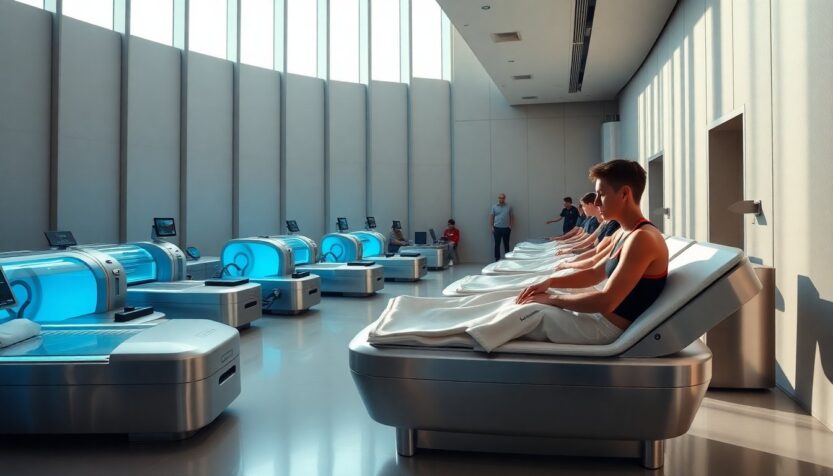Have you ever wondered how elite athletes like Novak Djokovic and Iga Swiatek recover from intense matches? Join me as we explore the exclusive recovery room at the US Open. This facility is a high-tech refuge designed to help players reset their minds and bodies during one of sports’ most demanding tournaments.
The Hidden World of Recovery Technology
Imagine this: beneath the iconic Arthur Ashe Stadium lies a recovery room so secretive that it is within another restricted area. Access requires a player badge, but I managed to obtain one. This is where champions recover using the Ammortal chamber, a sleek device priced at $159,500. It is said to reset the nervous system and provide hours of deep recovery in just 25 minutes—faster than waiting in line for a $23 Honey Deuce drink.
The Ammortal integrates various recovery modalities, including red-light therapy and vibroacoustic therapy, designed by experts familiar with human frequency. It syncs the body’s vibrations with calming music, creating a meditative experience for players. However, the company behind this technology has not officially confirmed its presence at the tournament. Speculation arose when Amanda Anisimova shared a photo of the chamber on Instagram, suggesting that players, including Djokovic, were using it. Djokovic is known for his dedication, having brought his own hyperbaric chamber in 2019.
Revolutionizing Recovery at the US Open
In a conversation with Marc Violone, the architect behind the players’ recovery suite, I learned that the US Open was the first tournament to establish a dedicated recovery space in 2019. Since then, it has evolved into the most advanced recovery facility on the tour, exceeding ATP requirements. This advancement is critical, as points earned at the Open can significantly impact player rankings.
Wim Fissette, coach of Iga Swiatek, emphasizes the necessity for players to maintain both physical and mental well-being. “You have to be improving constantly,” he states. The pressure of a long season filled with injuries and fatigue raises awareness of mental health among players. Alex de Minaur, currently ranked eighth in the world, has openly discussed his experience with burnout after Roland-Garros, highlighting the emotional challenges of the sport.
“Winning is everything, but it comes with suffering,” he asserts. “Finding a way to reset is essential.” Many players relate to this pressure.
The Neuroscience of Performance
As professional tennis evolves, so does the strategy for recovery. Coaches are increasingly prioritizing the regulation of athletes’ nervous systems to enhance performance. Jason Stacy, a performance coach, compares an athlete’s nervous system to a smartphone’s operating system: if it isn’t functioning well, nothing else will.
On the men’s side, Carlos Alcaraz has become a formidable player, partly due to his physiotherapist Juanjo Moreno, who focuses on training Alcaraz’s nervous system. Meanwhile, Taylor Fritz relies on his Eight Sleep mattress cover to calm his nervous system after intense matches.
During my visit to the recovery room, I passed through multiple security checkpoints to arrive at a serene oasis filled with binaural frequencies and essential oils. The atmosphere was calming, reminiscent of a spa. Each station featured Bang & Olufsen headphones, and the Ammortal chamber was discreetly positioned behind privacy screens, resembling a sci-fi device. Curtis Christopherson from Ammortal highlights its ability to induce a restorative state for hours, making it a favored choice for athletes seeking relaxation.
As players enter the room to alleviate stress before and after matches, they also address muscular issues and fatigue. Violone meticulously manages the room and reports that the Ammortal is the most popular recovery modality. This year, he has a list of over 50 unreleased recovery products on his phone.
The Future of Athletic Recovery
Imagine this: beneath the iconic Arthur Ashe Stadium lies a recovery room so secretive that it is within another restricted area. Access requires a player badge, but I managed to obtain one. This is where champions recover using the Ammortal chamber, a sleek device priced at $159,500. It is said to reset the nervous system and provide hours of deep recovery in just 25 minutes—faster than waiting in line for a $23 Honey Deuce drink.0
Imagine this: beneath the iconic Arthur Ashe Stadium lies a recovery room so secretive that it is within another restricted area. Access requires a player badge, but I managed to obtain one. This is where champions recover using the Ammortal chamber, a sleek device priced at $159,500. It is said to reset the nervous system and provide hours of deep recovery in just 25 minutes—faster than waiting in line for a $23 Honey Deuce drink.1
Imagine this: beneath the iconic Arthur Ashe Stadium lies a recovery room so secretive that it is within another restricted area. Access requires a player badge, but I managed to obtain one. This is where champions recover using the Ammortal chamber, a sleek device priced at $159,500. It is said to reset the nervous system and provide hours of deep recovery in just 25 minutes—faster than waiting in line for a $23 Honey Deuce drink.2

